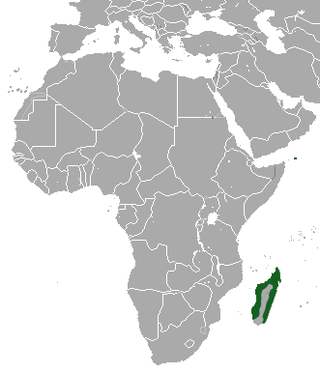Kuja is a genus of African moths of the family Thyrididae.

The Pyraloidea are a moth superfamily containing about 16,000 described species worldwide, and probably at least as many more remain to be described. They are generally fairly small moths, and as such, they have been traditionally associated with the paraphyletic Microlepidoptera.

The Thyrididae comprise the family of picture-winged leaf moths. They are the only family in the superfamily Thyridoidea, which sometimes has been included in the Pyraloidea, but this isn't supported by cladistic analysis.
Whalleyana is an enigmatic genus of moths in the lepidopteran group Obtectomera, endemic to Madagascar. The genus contains two species, whose biology are unknown. The genus had been placed in the picture-winged leaf moths, (Thyrididae), but then was placed in its own family, and later elevated to its own superfamily ; see also Fänger (2004). The genus was named after Paul E. S. Whalley, a British entomologist. Genomic studies have found them to be most closely related to Callidulidae, and it is suggested that they should be placed in Calliduloidea.

The Madagascan pygmy shrew is a species of mammal in the family Soricidae. It is the only known Malagasy shrew.

The brown-tailed mongoose, brown-tailed vontsira, Malagasy brown-tailed mongoose, or salano is a species of mammal in the family Eupleridae. It is endemic to Madagascar. Its natural habitat is moist lowland tropical forest. It is threatened by habitat loss.
Paul Mabille was a French naturalist mainly interested in Lepidoptera and botany.

Pachylemur is an extinct, giant lemur most closely related to the ruffed lemurs of genus Varecia. Two species are known, Pachylemur insignis and Pachylemur jullyi, although there is some doubt as to whether or not they may actually be the same species. Pachylemur is sometimes referred to as the giant ruffed lemur, because although it and the living ruffed lemurs had similar teeth and skeletons, Pachylemur was more robust and as much as three to four times larger. DNA studies have confirmed a sister group relationship between these two types of lemur. Like living ruffed lemurs, Pachylemur specialized in eating fruit, and was therefore an important seed disperser, possibly for tree species with seeds too large for even ruffed lemurs to swallow. In the spiny thickets of southwestern Madagascar, they were also likely to have dispersed seeds evolved to attach to fur and be carried away. Unlike ruffed lemurs, the fore- and hindlimbs of Pachylemur were nearly the same length, and therefore it was likely to be a slow, deliberate climber. However, both used hindlimb suspension to reach fruit on small branches below them.

Hypogeomys australis is an extinct rodent from central and southeastern Madagascar. First described in 1903, it is larger than its close relative, the living Hypogeomys antimena, which occurs further west, but otherwise similar. Average length of the femur is 72.1 mm, compared to 63.8 mm in H. antimena. One of the few extinct rodents of Madagascar, it survived to at least around 1536 BP based on radiocarbon dating. Little is known of its ecology, but it may have lived in burrows like its living relative and eaten some arid-adapted plants.
Alexey Nikolaievich Diakonoff, also transliterated as Alexej Nikolajewitsch Diakonoff, was a Russian–Dutch entomologist who specialised in Microlepidoptera.
William Warren was an English entomologist who specialised in Lepidoptera.
Hapana is a genus of moths of the family Thyrididae.
Hapana carcealis is a species of moth of the family Thyrididae. It is found in India, Tanzania, Kenya, Malawi, Seychelles (Aldabra), Comoros, Zimbabwe and Mauritius.
Hapana verticalis is a species of moth of the family Thyrididae. It is found in Nigeria, Cameroon, Angola, Namibia, Sierra Leone, Ivory Coast, Ghana, Democratic Republic of the Congo, Uganda, Sudan, Gabon, Kenya, Zimbabwe, Mozambique, South Africa and Tanzania.
Hapana minima is a species of moth of the family Thyrididae. It is found in Cameroon, Mozambique and Angola.

Banisia myrsusalis, the sapodilla borer or sapota midrib folder, is a species of moth of the family Thyrididae. It was described by Francis Walker in 1859 and is found in North America, Brazil, Australia, southern Asia and Africa.
Sijua is a genus of moths of the family Thyrididae from Africa.
Archidrepana is a monotypic moth genus belonging to the subfamily Drepaninae. This genus was erected by William Warren in 1902. Its only species, Archidrepana saturniata, described by the same author in the same year, is known from the Comoros and from Madagascar.

Sapindoideae is a subfamily of flowering plants in the soapberry family, Sapindaceae. It includes a number of fruit trees, including lychees, longans, rambutans, and quenepas.







